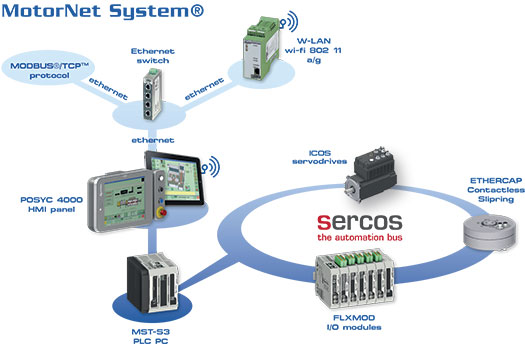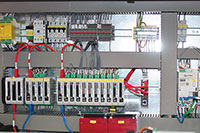Automation 4.0
In SMI stretch-blow moulders, designed according to INDUSTRY 4.0 parameters, fully automatic processes, electronically-controlled operations and wiring by field bus are synonyms of reliability, considerable operational flexibility and high performance. Hardware and software components are IoT (Internet of Things) ready, are “open“ and modular, comply with the most important international certifications and rely upon consolidated standards of the industrial field and of the packaging sector: OMAC guidelines (Open Modular Architecture Controls), sercos, PROFIBUS, IEC61131, OPC, Industrial PC.
In particular, by following the OMAC guidelines and the Omac Packaging Workgroup (OPW), SMI can guarantee easy integration with the other machines in line, user friendly technology and maintenance of the investment value. The automation and control system of SMI machines, called MotorNet System®, includes the following hardware components: MARTS (process controller), POSYC (manmachine interface), COSMOS (digital servodriver for brushless motors), dGATE and aGATE (remote IP65 I/O digital/analogic modules).
The MARTS is a PAC (Programmable Automation Controller), based on an industrial PC, which can be programmed in IEC61131 languages. The COSMOS servodrivers and the dGATE/aGATE I/O modules are connected to the PAC via sercos. The POSYC is a HMI terminal, (touch screen IP65), based on an industrial PC with solid state drives.
SMI stretch-blow moulders are very easy to use; in fact, thanks to the MotorNet System® technology, it is possible:
- To set the heating profile for each preform and the parameters influencing the phases of the stretch-blowing process (from when the preform enters the heating module up to the container)
- To adjust the power of each lamp in each section of the heating module
- To control the operation parameters of each stretch-blowing station and monitor the whole stretch-blowing process in real time
- To store the parameters of each blown container
- To check and set the machine production speed, according to the different types of containers
- To carry out the changeover in a quick and easy way
- To solve or prevent any problems, thanks to the teleservice, the graphic alarms displayed on the POSYC and the signal of the maintenance interventions to be carried out
- To have access to the on-line manuals on the POSYC
- To ensure high outputs, excellent quality levels and very low noise
- To monitor the performance and analyse the down-times (Pareto diagram)
- To interchange the POSYC with compatible Panel PC (SIEMENS, ALLEN BRADLEY)
- To interchange the COSMOS with compatible sercos pack profile servodrivers.
Contact us
- SMI S.p.A.
- Address: Via Carlo Ceresa, 10
24015 San Giovanni Bianco BG
Italy - Phone: +39 0345 40.111
- E-mail: info@smigroup.it
- Monday - Friday: 07:45 - 17:30
Saturday - Sunday: Closed
Privacy statement
DATA PROTECTION AND PRIVACY

The European Regulation 679/2016 (GDPR) on the protection of personal data has been fully applicable since May 25th, 2018. This is an important goal, because it lays down rules relating to the processing of personal data for all Countries within the Union. Every company of the SMI Group planned a series of activities, assets or operational modes to comply with the regulation and put into practice the protection of personal data. Here is a list of actions taken to comply with the European Regulation and our policy on personal data processing.
![]()
Lawfulness of processing
All activities relating to personal data processing shall be lawful (consent, contract obligations, vital interests of the data subject or of third parties, compliance with legal obligations to which the controller is subject, public interest or exercise of official authority, legitimate interest pursued by the controller or by third parties).
![]()
Information document
The information statement has been improved and updated to the new regulations (art. 13 and 14 GDPR).
![]()
Rights of the data subjects (right of access, right to erasure-right to be forgotten, right to restriction of processing, right to object, right to data portability)
Technical and organization measures have been adopted to ensure the data subject's exercise of his rights and to meet the data subject requirements.
![]()
Controllers, processors
Based on the new principle of “accountability”, SMI Group organization was re-defined, in order to proactively ensure integral compliance with the Regulation.
Redefinition of the role of data processors and service suppliers whose activity implies personal data processing.
![]()
Risk of data processing; accountability measures taken by controllers and processors (Impact assessment, record of processing activities, security of processing, data breach)
The “Conformity document”, including records of data processing activity, plans, adopts and demonstrates all technical and organizational measures taken to adequately perform the data processing activities and specifies the necessary procedures to be adopted to notify data breach.
![]()
Transfer of personal data to international organizations
Smi Group adheres to the general principles and guarantees concerning the transfer of personal data to third Countries.
The Controller is:
SMI S.p.A.
Head office: Via Carlo Ceresa, 10 - 24015 San Giovanni Bianco (BG) - ITALIA
P.I.: 04471940165 - C.F.: 03942700166 - R.E.A.: 421708
For further information, write to: privacy@smigroup.net
According to the European Regulation 679/2016, the data subject is entitled to exercise the rights set forth in the Regulation.
The integral version of art. 15; 16; 17; 18; 20; 21; 77 of the European Regulation is attached to this document.
In order to exercise your rights, please send the application form duly filled in to the Controller's address.
Legal notice
SMI S.p.A. con Unico Socio
Società sottoposta a direzione e coordinamento da SMIGROUP S.p.A.
Società appartenente al GRUPPO IVA SMI INDUSTRIES
Sede amministrativa e Unità produttiva:
Via Carlo Ceresa, 10 - 24015 San Giovanni Bianco (BG) - ITALIA
Tel. +39 0345 40.111 - Fax: +39 0345 40.209 - www.smigroup.it
C.F. 03942700166 - P. IVA IT04471940165 - R.E.A. 421708
Iscr.Reg.Imprese 03942700166 - Cap. Soc. € 5.000.000 i.v.
Sede legale: Via Monte Grappa, 7 - 24121 Bergamo (BG) - ITALIA













